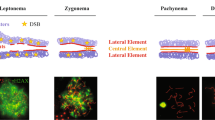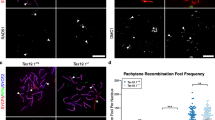Abstract
If the sex-reversal factor (Sxr) in mice is represented by a segment of the Y chromosome translocated on to an autosome, this segment might be expected to show some evidence of attempted pairing with the normal Y chromosome at the first meiotic division. Our failure to find such evidence in a light microscope study of the silver-stained pachytene spermatocytes from Sxr/+, XY males further supports existing cytological information that the factor is more likely to be represented by an autosomal dominant gene mutation.
Similar content being viewed by others
References
Boer, P. de: Personal communication. Mouse News Letter 60, 78 (1979)
Boer, P. de, Branje, H.E.B.: Association of the extra chromosome of the tertiary trisomic male mice with the sex chromosomes during first meiotic prophase and its significance for the impairment of spermatogenesis. Chromosoma (Berl.) 73, 369–379 (1979)
Burtenshaw, M.D., Brown, B.B.: Mouse News Letter 62, 70 (1980)
Cacheiro, N.L.A., Russell, L.B., Swartout, M.S.: Translocations, the predominant cause of total sterility in sons of mice treated with mutagens. Genetics 76, 73–91 (1973)
Cattanach, B.M., Pollard, C.E., Hawkes, S.G.: Sex reversed mice: XX and XO males. Cytogenetics 10, 318–337 (1971)
Cattanach, B.M.: Sex reversal in the mouse and other mammals. In: The Early Development of Mammals. British Society for Developmental Biology, Symposium 2, 305–317 (M. Balls and A.E. Wild, (eds.). Cambridge University Press 1975
Crocker, M.: Mouse News Letter 62, 51 (1980)
Ford, C. E.: Meiosis in mammals, In: Comparative Mammalian Cytogenetics (K. Benirschke ed.), 91–106. New York: Springer Verlag 1969
Forejt, J.: Non-random association between a specific autosome and the X chromosome in meiosis of the male mouse. Possible consequences of homologous centromeric separation. Cytogenet. Cell. Genet. 13, 369–383 (1974)
Forejt, J.: Meiotic studies of translocations causing male sterility in the mouse. II. Double heterozygotes for Robertsonian translocations. Cytogenet. Cell Genet. 23, 163–170 (1979)
Forejt, J., Gregorova, S.: Meiotic studies of translocations causing male sterility in the mouse. I. Autosomal translocations. Cytogenet. Cell Genet. 19, 159–179 (1977)
Jagiello, G., Fang, J.S., Turchin, H.A., Lewis, S.E., Gluecksohn-Waelsch, S.: Cytological observation of deletions in pachytene stages of oogenesis and spermatogenesis in the mouse. Chromosoma (Berl.) 58, 377–386 (1976)
Leonard, A., Deknudt, G.H.: The sensitivity of various germ-cell stages of the male mouse to radiation induced translocations. Canad. J. Genet. Cytol. 10, 495–507 (1968)
Lyon, M.F., Evans, E.P., Jarvis, S.E., Sayers, I.: t-Haplotypes of the mouse may involve a change in intercalary DNA. Nature (Lond.) 279, 38–42 (1979)
Miller, D.A., Dev, V.G., Tantravahi, R., Miller, O.J., Schiffmann, M.B., Yates, R.A., Gluecksohn-Waelsch, S.: Cytological detection of the C25H deletion involving the albino (c) locus on chromosome 7. Genetics 78, 905–910 (1974)
Moses, M.J.: Synaptonemal complex karyotyping in spermatocytes of the Chinese Hamster (Cricetulus griseus). I. Morphology of the autosomal complement in spread preparations. Chromosoma (Berl.) 60, 99–125 (1977)
Moses, J.J.: Microspreading and the synaptonemal complex in cytogenetic studies. Chromosomes today 6, 71–82 (1978)
Moses, J.J., Russell, L.B., Cacheiro, N.L.A.: Mouse chromosome translocations: visualization and analysis by electron microscopy of the synaptonemal complex. Science 196, 892–894 (1977)
Ohno, S., Cattanach, B.M.: Cytological study of an X-autosome translocation in Mus musculus. Cytogenetics 1, 129–140 (1962)
Searle, A.G., Ford, C.E., Evans, E.P., Beechey, C.V., Burtenshaw, M.D., Glegg, H.C.: The induction of translocations in mouse spermatozoa. I. Kinetics of dose response with acute X-irradiation. Mutation Res. 22, 157–167 (1974)
Tres, L.: Extensive pairing of the XY bivalent in mouse spermatocytes as visualized by whole mount electron microscopy. J. Cell Sci. 25, 1–15 (1977)
Tres, L.: Translocation of the Y-paracentromeric region to an autosomal bivalent in Sxr, XY mouse spermatocytes. J. Cell Biol. 79, 125a (1978)
Winsor, E.J.T., Ferguson-Smith, M.A., Shire, J.G.M.: Meiotic studies in mice carrying the sex reversal (Sxr) factor. Cytogenet. Cell Genet. 21, 11–18 (1978)
Author information
Authors and Affiliations
Rights and permissions
About this article
Cite this article
Evans, E.P., Burtenshaw, M.D. & Brown, B.B. Meiosis in Sxr male mice. Chromosoma 81, 19–26 (1980). https://doi.org/10.1007/BF00292420
Received:
Accepted:
Issue Date:
DOI: https://doi.org/10.1007/BF00292420




